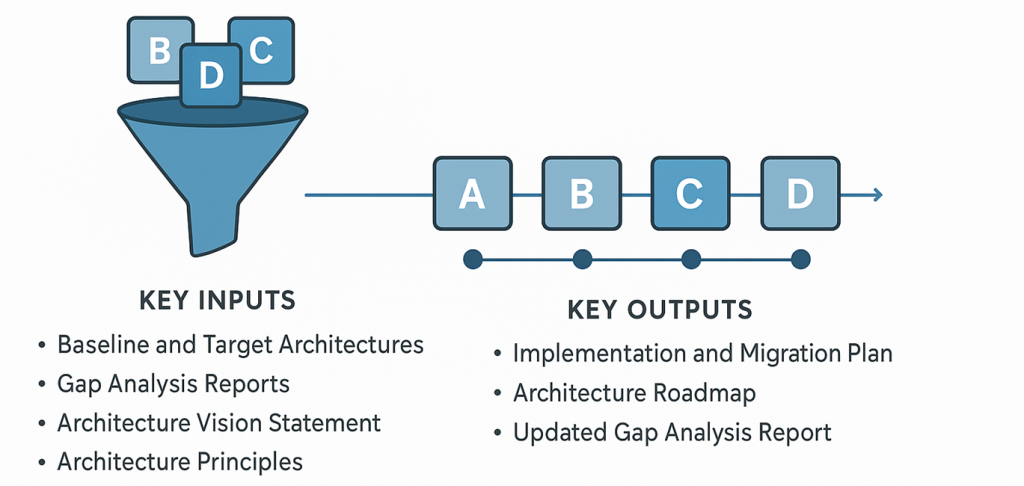Phase E – From Design to Reality
Having completed the detailed design work in Phases B, C, and D, the ADM cycle now enters Phase E – Opportunities & Solutions. This is the crucial stage where the focus shifts from what to how. The logical designs are consolidated, and a tangible plan is created for how to implement the target architecture.
The main purpose of Phase E is to generate a comprehensive plan for implementation and migration. This involves identifying the major work packages, grouping them into logical projects, and prioritizing them to create a clear roadmap for the enterprise’s transformation.
Key Inputs of Phase E
To begin Phase E, architects rely on the detailed outputs from all previous design phases:
- Baseline and Target Architectures: The full set of architectures from Phases B, C, and D, covering business, data, application, and technology domains.
- Gap Analysis Reports: The detailed reports identifying the gaps between the baseline and target architectures.
- Architecture Vision Statement: The guiding document that ensures the implementation plan aligns with the overall business goals.
- Architecture Principles: The principles that govern all architectural decisions.
Core Activities and Steps of Phase E
The activities in Phase E focus on consolidating the architecture work and creating a practical implementation plan.
- Consolidate and Refine Architectures: The designs from Phases B, C, and D are brought together to create a single, cohesive view of the target architecture. Any remaining inconsistencies or overlaps are resolved.
- Identify and Group Work Packages: Based on the gaps identified and the new architecture models, logical “work packages” are defined. These are the major, high-level projects or initiatives required for implementation.
- Create an Architecture Roadmap: This is a key activity. The roadmap is a high-level, visual plan that shows the sequence of work packages over time. It helps stakeholders understand the order and timing of the transformation.
- Analyze Dependencies and Constraints: The relationships between work packages are analyzed to identify dependencies (e.g., Project B cannot start until Project A is complete). This analysis is critical for building a realistic timeline.
- Develop the Implementation and Migration Plan (Initial Version): A high-level plan is created to outline how the identified projects will be managed. This plan addresses key aspects like project governance, risk management, and resource allocation.
- Assess Business Value and Prioritize: Each work package is evaluated based on its business value, cost, and risk. This information is used to prioritize the projects and create a sequenced roadmap that delivers the most value early on.
Key Outputs of Phase E
The successful completion of Phase E produces several crucial outputs that guide the enterprise’s transformation.
- Implementation and Migration Plan: A comprehensive plan that outlines the projects, timelines, and resources required to transition from the current to the target architecture.
- Architecture Roadmap: A visual representation of the implementation plan, showing the sequence of work packages over time.
- Updated Gap Analysis Report: A final, consolidated report of all identified gaps.
- Architectural Contract: A formal agreement between the development team and the Architecture Board, outlining the responsibilities and expectations for the implementation projects.

Conclusion
Phase E – Opportunities & Solutions is a pivotal stage that translates architectural vision into a practical, actionable plan. By meticulously planning the implementation and migration, architects can ensure the enterprise transformation is not only technically feasible but also strategically sound and aligned with business priorities.
In our next article, we will move on to Phase F – Migration Planning, where we will refine this plan and formalize the implementation strategy.